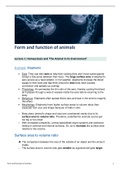Summary
Summary BIO154: Form and Function of Animals notes
- Course
- Biology 154 (BIO154)
- Institution
- Stellenbosch University (SUN)
Biology 154 Lectures Notes that just includes the section of Form and Function of Animals. It contains additional information for better understanding.
[Show more]



